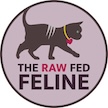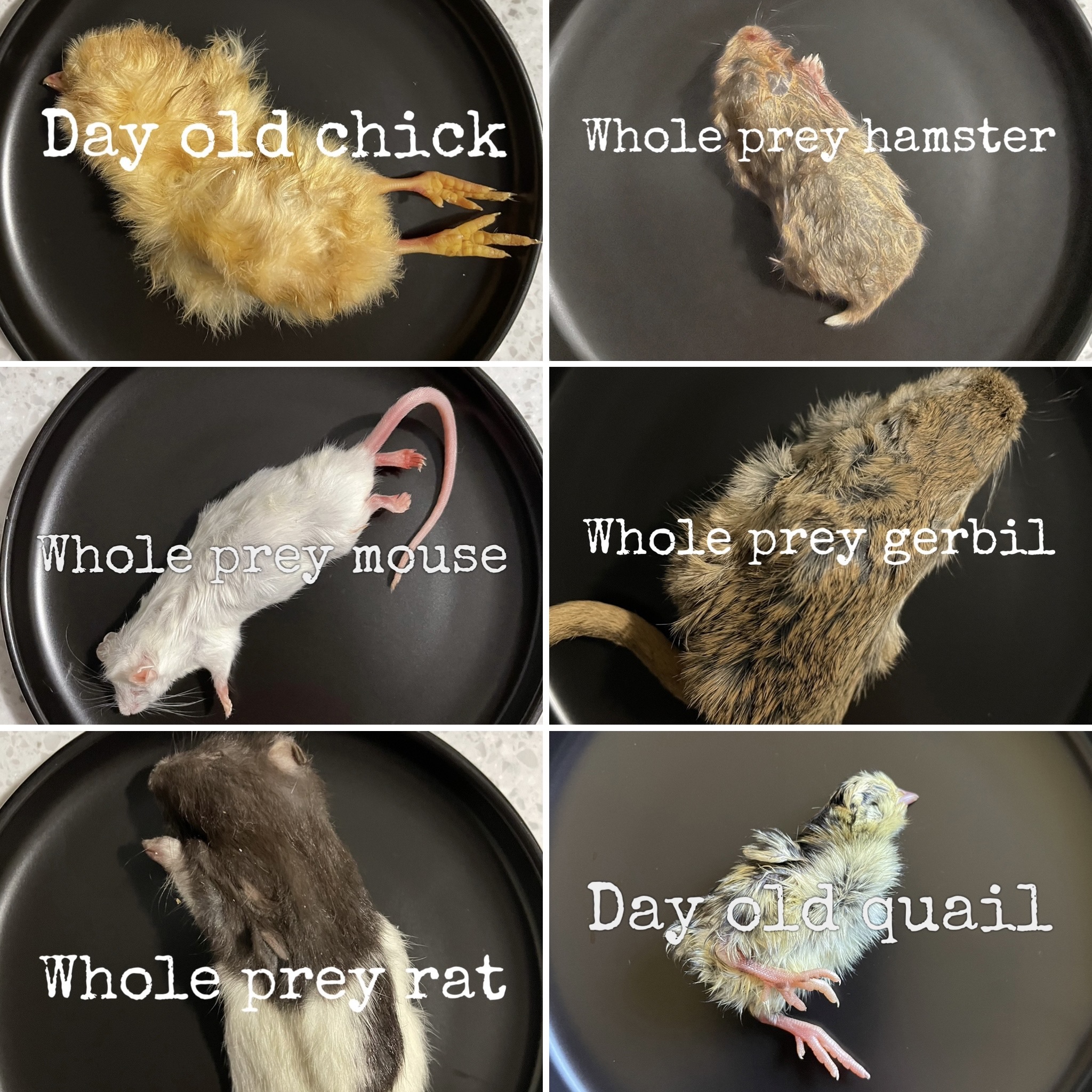Let’s talk about whole prey feeding. This may be one of the most controversial ways to feed raw for people. (To note—this is not controversial for cats since this is what they would naturally eat.) But it can be difficult for many people to see the mouse or chick intact. When I was a new raw feeder and first heard about whole prey, I remember thinking that it was a line that I wouldn’t cross. I would feed raw other ways, but I could not imagine feeding whole prey.
As I continued to learn more about how raw feeding is basically trying to nutritionally recreate whole prey, I became more and more curious about it. I also had to make a shift in my thinking from focusing on my feelings about it to focusing on how cats are designed to eat. Fast forward to now—I feed Hazel whole prey daily and am a big proponent of whole prey feeding!
What is whole prey?
Whole prey animals fed to cats include mice, rats, chicks, quail, rabbit kits, gerbils, hamsters, and guinea pigs. Whole prey is exactly that—the whole animal: fur and feathers included. Just to be clear, feeding live prey is not condoned and is considered unnecessarily cruel given the way that cats “play” with their prey. Whole prey feeding cats always consists of feeding thawed frozen animals.
Animals purchased from online suppliers are humanely euthanized using CO2 and then frozen. No euthanasia drugs are used, so there are no drugs in the prey animals that your cat would then consume. Feeder animals from reputable suppliers are raised humanely in clean conditions and should be disease and parasite free. You need only to thaw in the refrigerator, which makes whole prey feeding one of the easiest ways to feed raw.
The size of the animals you feed can make a difference in terms of nutritional value. Baby animals, such as day old quail or chicks or baby rodents (pinkies, hoppers, fuzzies) are not done developing. Therefore, they don’t have the needed level of nutrients to be considered a nutritionally complete meal, especially when it comes to the essential minerals found in bones. However, baby animals are a great option to offer as treats and for getting started. Adult animals can be fed as a meal within an overall balanced diet. Examples of these animals would include adult mice, rats, other rodents, and larger quail. Here is some information about the nutritional composition of commonly fed whole prey.

Benefits of feeding whole prey
There are numerous benefits to feeding whole prey. Nutritionally speaking, the benefits are many. Fur, feathers, and connective tissues provide animal based fiber, which helps keep the overall digestive tract in good working order. The thyroid gland of the animal is consumed, which provides a perfect micro-dose of iodine. Size and density appropriate bones provide the needed calcium, phosphorus, and magnesium. Blood and other bodily fluids are present for iron and the needed moisture. All organs, muscular and secreting, are consumed in the meal when eating whole prey, with all of the nutritional benefits of each. Whole prey is a perfectly packaged meal for our little carnivores.
There are some other significant benefits of eating whole prey that are not directly related to nutrition. When cats eat whole prey, their minds are actively engaged in the eating process. Eating becomes “work” and they have to problem solve how to go about eating the animal. The meal becomes a source of mental stimulation and enrichment. As cats eat whole prey animals, their brains release endorphins, which creates a sense of pleasure for them. (Hazel LOVES her whole prey meals more than any other.) There are also considerable oral health benefits as their teeth rip, tear, and crunch bones and connective tissues.
How to introduce
Since most house cats don’t grow up eating whole prey, there can be a significant transition period needed to help them even recognize a chick or mouse as food. Whole prey looks unlike any other food most cats are regularly fed and has minimal, if any, smell. To encourage a cat to eat whole prey, you can cut the animal open, sprinkle crushed freeze dried treats or nutritional yeast on it, or serve alongside their usual food. Start with smaller, baby animals and work up to larger sized animals over time.
What worked best with Hazel was to offer whole prey alongside her regular food to help her associate it as food to be eaten. I poured some of the juices from her meal on a chick at first. The smell of the juices helped her understand that this was food for eating, not just for playing with. Many cats will play with whole prey the first several times it is offered to them by tossing it up in the air and batting it around! Hazel started with chicks and would only eat those for what felt like the longest time. I kept offering mice though, and eventually one day she ate one! She has eaten a variety of whole prey ever since.
Where to find whole prey
Whole prey animals are usually purchased from online suppliers. They are typically only available in bulk amounts, which is the most economical way to buy them. Some raw food suppliers offer whole prey in lesser quantities to purchase as well. Local pet stores that have a frozen section and cater to reptile owners will often have frozen mice available. Local reptile shops or reptile expos will have frozen feeder whole prey items such as mice, rats, and/or other rodents. Buying individual animals this way is expensive, but it is a great way to try some whole prey out with your cat before committing to buying in bulk. Feeding whole prey is biologically appropriate, but can also be pretty expensive.
When purchasing from online suppliers, ask other whole prey feeders for their experiences, read reviews, and check the suppliers’ refund policy in case you are not satisfied with the quality of the animals you receive. Whole prey animals should be clean, have minimal odor, and appear otherwise healthy. There are some important variables that you don’t have control over when you purchase whole prey from suppliers, such as the diet fed, care, breeding, etc. These variables impact the nutritional composition of the animals, so you want to use reputable suppliers when feeding whole prey to ensure the best nutrition.

Come across the line
Offering whole prey can be a fun and natural way to supplement and enrich your cat’s diet. Whole prey makes for great treats and/or meals offered within an overall balanced diet. Feeding Hazel whole prey has been such a wonderful learning experience for me. It has been very satisfying to be able to offer her food in the form that she was designed to eat and see her reap the many benefits of doing so. Whereas whole prey feeding originally felt like a line I didn’t want to cross, now I whole heartedly encourage others to come across that line for their cats, too!



One response to “Whole prey feeding: controversial or just right for carnivores?”
Thank you for sharing your knowledge, Jennifer. I think whole prey feeding is the natural progression to feeding cats a biologicallly species appropriate diet.